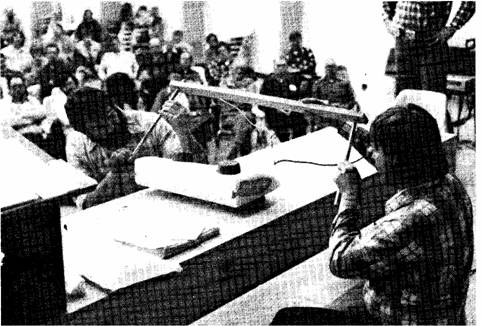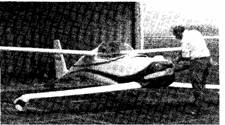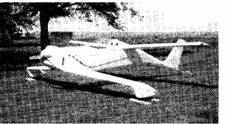 |
 |
 |

This demonstration of proper hot-wiring techniques took place at a construction
seminar sponsored by Quickie Aircraft of Minnesota. Over 100 people attended. |
for his initial flights. When he
returns the prop to us in good shape, prepaid freight, we will return his
complete deposit.
We request that builders use the special unlisted Builder Hotline number
only for construction questions; please no backorder, option orders, or
delivery date questions.
We want again this month to caution builders against using the small skull
cap spinners on the Quickie. They are just not secured well enough, and
the result of one coming off in the air is at minimum a forced landing.
Recently, we discovered that we had not shipped backorders to several Quickie
builders due to a filing slipup. We sent out over 100 letters to catch
the few we may have missed. We are making a concerted effort in February
to complete all backorders, and have hired additional personnel for that
purpose.
Prior to the first flight, each Quickie builder should break his engine
in for a minimum of 8-10 hours. This can be done in the airframe, with
the aircraft tied down, and the engine allowed to run. The r.p.m. should
be varied periodically and all temperatures and pressures monitored at
all times. No full throttle static runs should be made prior to 5 hours.
Inspect for fuel contamination in all fuel lines and filters after each
ground run and after the first several flights.
continued on page 2

Richard Menning's Quickie.

The pretty Quickie of Jerome Peek and Gordon Reneberg.
|

Over 125 Quickies have made first flights. Testing continues on the TurboOnan
installed in N8OQA. We are currently working on resolving some carburetion
problems with the installation.
It is strongly recommended that Quickie pilots periodically verify and
calibrate their tachometers using another tach of known accuracy, such
as a hand held Heathkit model or Sears Auto-Analyzer unit. Inaccurate tachs
do not permit the pilot to monitor his engine properly. The 18 hp. engine
should turn 3000 r.p.m. static with full throttle; the 22 h.p. versions
should turn 3150 r.p.m. static under the same conditions. If you don’t
know what your static r.p.m. is, you should not take off.
As has been pointed out in the Quickie Newsletter, and emphasized in the
Quickie Construction Plans, it is very important to have a smooth, wavefree
forward canard surface. Refer to the plans for complete specifications.
Recently, a builder painted some stripes on the leading edge of his canard.
The edges of the paint, where the tape ran, were far in |
excess of the acceptable thickness. The result
was a canard with a low maximum lift, thus raising the stall speed, reducing
the performance, and making the aircraft feel nose heavy. We will demonstrate
the proper procedures for checking and finishing the forward canard surface
at the upcoming seminar.
In level flight at cruise power, the elevator position of a Quickie at
mid c.g. should be about -5 degrees (i.e., 5 degrees trailing edge
up). All Quickie pilots should check this at the next opportunity. It is
an acceptable means of determining that the wing and canard are at the
proper relative incidence. If the elevator position in cruise is much below
-5 degrees, the Quickie may feel nose heavy, particularly in the rain.
Some performance degradation may also be anticipated. This result was noted
and examined on a Southern California Quickie.
For those builders who would like a true climb propeller for the first
few flights, rather than the cruise propeller provided with the kits, we
have created a 42” diameter, 27” pitch climb propeller and
will make it available as follows: with a deposit by the builder of $150.00,
we will send the special prop to the builder |
|

